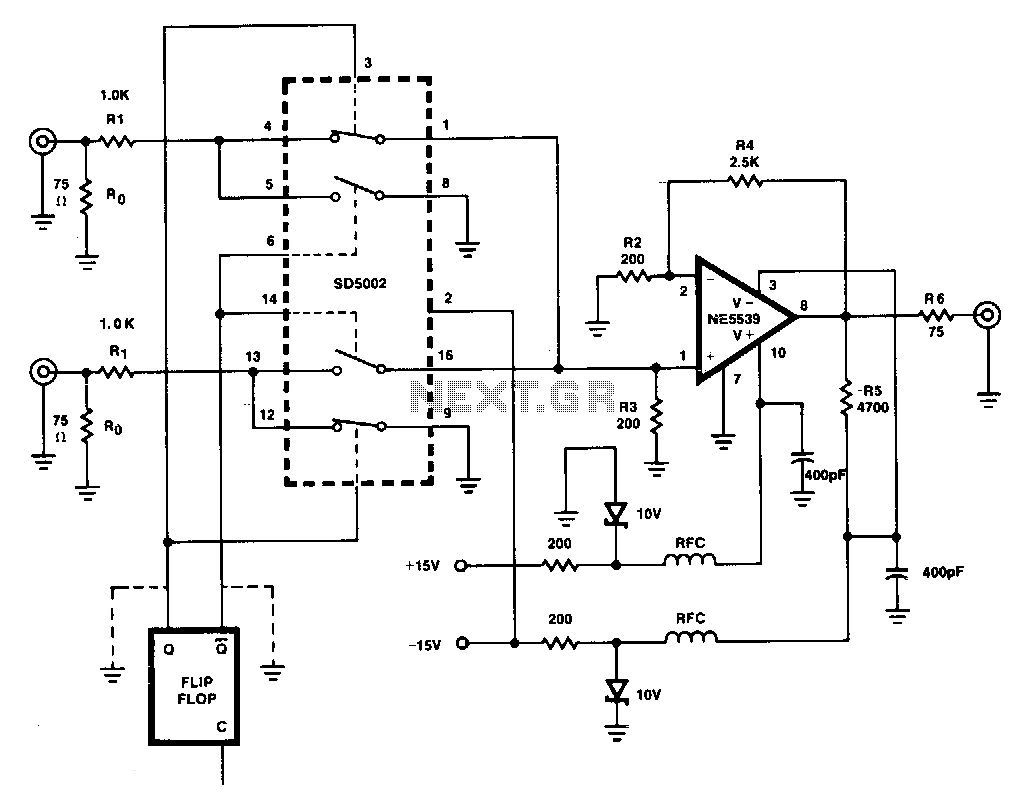
High-performance-video-switch

This figure illustrates a one-of-two switch featuring a summing amplifier. The video source's line can be terminated either externally or internally to switch RO. With this termination resistor, a load change of less than 10 ohms will be perceived by the source when the switch changes state. Consequently, input isolation amplifiers are not necessary. R4 can be adjusted to control circuit gain but should never be less than 1400 ohms, as the NE5539 is internally compensated for gain values greater than seven. A value of approximately 2500 ohms for R4 will configure the circuit gain close to unity. Furthermore, the circuit output impedance is determined by R6, while R5 establishes the output DC offset to near zero.
The schematic represents a one-of-two switch configuration utilizing a summing amplifier to manage video signal routing. This configuration allows for flexible signal termination, either externally or internally, to the designated switching point (switch RO). The termination resistor plays a crucial role in minimizing the load change perceived by the video source during state transitions of the switch, ensuring that the source remains stable and unaffected by minor load variations, which is critical for maintaining signal integrity.
The NE5539 operational amplifier is employed in this design due to its high performance and internal compensation, which simplifies gain adjustments. The resistor R4 is pivotal in setting the gain of the amplifier circuit. It is essential to maintain R4 at a value no less than 1400 ohms to ensure proper operation within the specified gain range. A typical setting of 2500 ohms for R4 will yield a gain close to unity, allowing for effective signal amplification without introducing excessive noise or distortion.
The output impedance of the circuit is defined by resistor R6, which is essential for matching the output stage to subsequent circuit components. This matching is crucial for optimizing signal transfer and minimizing reflections in high-frequency applications. Resistor R5 is used to adjust the output DC offset, ensuring that the output signal remains centered around zero volts, which is particularly important for AC-coupled applications where DC offsets can introduce distortion or affect downstream processing.
Overall, this circuit design provides a robust solution for managing video signals with minimal interference and optimal performance, making it suitable for a variety of audio-visual applications.This figure shows a one-of-two switch with a sunnning amplifier. The video source"s line can be terminated either externally or internally to switch RO. With this termination resistor, a load change of less than 1 0 will be seen by the source when the switch changes state. For this reason, input isolation amplifiers are. not necessary. R4 can be varied to control circuit gain, but should never be less than 1400 0 since the NE5539 is internally compensated for gain values greater than seven.
A value of approximately 2500 {} for R4 will set circuit gain to near unity. Additionally, the circuit output impedance is set by R6, and R5 sets the output de offset to near zero. 🔗 External reference
The schematic represents a one-of-two switch configuration utilizing a summing amplifier to manage video signal routing. This configuration allows for flexible signal termination, either externally or internally, to the designated switching point (switch RO). The termination resistor plays a crucial role in minimizing the load change perceived by the video source during state transitions of the switch, ensuring that the source remains stable and unaffected by minor load variations, which is critical for maintaining signal integrity.
The NE5539 operational amplifier is employed in this design due to its high performance and internal compensation, which simplifies gain adjustments. The resistor R4 is pivotal in setting the gain of the amplifier circuit. It is essential to maintain R4 at a value no less than 1400 ohms to ensure proper operation within the specified gain range. A typical setting of 2500 ohms for R4 will yield a gain close to unity, allowing for effective signal amplification without introducing excessive noise or distortion.
The output impedance of the circuit is defined by resistor R6, which is essential for matching the output stage to subsequent circuit components. This matching is crucial for optimizing signal transfer and minimizing reflections in high-frequency applications. Resistor R5 is used to adjust the output DC offset, ensuring that the output signal remains centered around zero volts, which is particularly important for AC-coupled applications where DC offsets can introduce distortion or affect downstream processing.
Overall, this circuit design provides a robust solution for managing video signals with minimal interference and optimal performance, making it suitable for a variety of audio-visual applications.This figure shows a one-of-two switch with a sunnning amplifier. The video source"s line can be terminated either externally or internally to switch RO. With this termination resistor, a load change of less than 1 0 will be seen by the source when the switch changes state. For this reason, input isolation amplifiers are. not necessary. R4 can be varied to control circuit gain, but should never be less than 1400 0 since the NE5539 is internally compensated for gain values greater than seven.
A value of approximately 2500 {} for R4 will set circuit gain to near unity. Additionally, the circuit output impedance is set by R6, and R5 sets the output de offset to near zero. 🔗 External reference